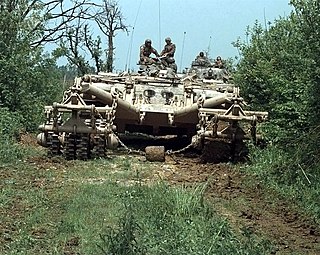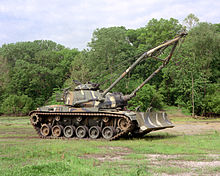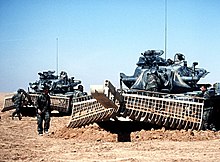
A military engineering vehicle is a vehicle built for construction work or for the transportation of combat engineers on the battlefield. These vehicles may be modified civilian equipment or purpose-built military vehicles. The first appearance of such vehicles coincided with the appearance of the first tanks, these vehicles were modified Mark V tanks for bridging and mine clearance. Modern military engineering vehicles are expected to fulfill numerous roles such as; bulldozer, crane, grader, excavator, dump truck, breaching vehicle, bridging vehicle, military ferry, amphibious crossing vehicle, and combat engineer section carrier.

The M1 Abrams is a third-generation American main battle tank designed by Chrysler Defense and named for General Creighton Abrams. Conceived for modern armored ground warfare and now one of the heaviest tanks in service at nearly 73.6 short tons. It introduced several modern technologies to United States armored forces, including a multifuel turbine engine, sophisticated Chobham composite armor, a computer fire control system, separate ammunition storage in a blowout compartment, and NBC protection for crew safety. Initial models of the M1 were armed with a 105 mm M68 gun, while later variants feature a license-produced Rheinmetall 120 mm L/44 designated M256.

A mine roller or mine trawl is a demining device mounted on a tank or armoured personnel carrier, designed to detonate anti-tank mines. It allows engineers to clear a lane through a minefield which is protected by enemy fire.

The M48 Patton is an American first-generation main battle tank (MBT) introduced in February 1952, being designated as the 90mm Gun Tank: M48. It was designed as a replacement for the M26 Pershing, M4 Sherman, M46 and M47 Patton tanks, and was the main battle tank of the U.S. Army and U.S. Marine Corps in the Vietnam War. Nearly 12,000 M48s were built, mainly by Chrysler and American Locomotive Company, from 1952 to 1961. The M48 Patton was the first U.S. medium gun tank with a four-man crew, featuring a centerline driver's compartment and no bow machine gunner. As with nearly all new armored vehicles it had a wide variety of suspension systems, cupola styles, power packs, fenders and other details among individual tanks.

The M60 is an American second-generation main battle tank (MBT). It was officially standardized as the Tank, Combat, Full Tracked: 105-mm Gun, M60 in March 1959. Although developed from the M48 Patton, the M60 tank series was never officially christened as a Patton tank. It has been called a "product-improved descendant" of the Patton tank's design. The design similarities are evident comparing the original version of the M60 and the M48A2. The United States fully committed to the MBT doctrine in 1963, when the Marine Corps retired the last (M103) heavy tank battalion. The M60 tank series became America's primary main battle tank during the Cold War, reaching a production total of 15,000 M60s. Hull production ended in 1983, but 5,400 older models were converted to the M60A3 variant ending in 1990.

Anniston Army Depot (ANAD) is a major United States Army facility for the production and repair of ground combat vehicles, overhaul of Small Arms Weapon Systems and the storage of chemical weapons, a.k.a. the Anniston Chemical Activity. The depot is located in Bynum, Alabama.

The M4 Sherman tank was produced in several variants, a result of mass production spread across several manufacturers and several years. It was also the basis for a number of related vehicles and Shermans have been modified by several nations, ranging from upgrades to complete hull conversions for another task. Originally designed in 1941, M4 variants were still used by Israel during the 1967 and 1973 wars with its Arab neighbors.
Tank development both evolved considerably from World War II and played a key role during the Cold War (1945–1990). The period pitted the nations of the Eastern Bloc and the North Atlantic Treaty Organization (NATO against each other.

The M60 Armored Vehicle Launched Bridge (AVLB) is an armored vehicle based on the M60 Patton main battle tank's hull and used for the launching and retrieval of a 60-foot (18 m) scissors-type bridge. The AVLB consists of three major sections: the launcher, the vehicle hull, and the bridge. The M60 AVLB or Armored Vehicle Launched Bridge was introduced in 1963. This combat engineer vehicle was developed by the US Army Engineer Research & Development Laboratories under contract with General Dynamics to replace the previous M48 AVLB. It was designed to launch bridge for tanks and other wheeled combat vehicles across trenches and water obstacles in combat conditions. A total of 400 armored bridge launchers and bridges were built. 125 M60 AVLBs of all variants were constructed.

An armoured vehicle-launched bridge (AVLB) is a combat support vehicle, sometimes regarded as a subtype of military engineering vehicle, designed to assist militaries in rapidly deploying tanks and other armoured fighting vehicles across gap-type obstacles, such as rivers. The AVLB is usually a tracked vehicle converted from a tank chassis to carry a folding metal bridge instead of weapons. The AVLB's job is to allow armoured or infantry units to cross craters, anti-tank ditches, blown bridges, railroad cuts, canals, rivers and ravines, when a river too deep for vehicles to wade through is reached, and no bridge is conveniently located, or sufficiently sturdy, a substantial concern when moving 60-ton tanks.

The Puma is a heavily armored Combat engineering vehicle and armored personnel carrier that the Engineering Corps of the Israeli Defence Forces has used since the early 1990s. The vehicle can carry a crew of up to eight. The 50-ton vehicle's speed is 45 kilometers an hour.
The General Dynamics Land Systems (GDLS) M60-2000 or 120S was an upgrade of the M60 tank. The development of the M60-2000 was initiated primarily due to the large number of M60 main battle tanks in service with many Middle Eastern nations unable to afford a sufficient force of more modern main battle tanks. The upgrade was marketed at those M60 users with the industrial capability to convert the tanks themselves. The M60-2000/120S was a GDLS supplied conversion kit that married the turret of the M1A1 variant of the M1 Abrams to the M60A1 hull of the M60, offering many features of the M1A1 Abrams to existing M60 users at a reduced cost.

The Trojan Armoured Engineer Vehicle (AEV) is a combat engineering vehicle of the British Army. It is used to breach minefields and for many other tasks. It is currently in use with the Royal Engineers.

The United States has produced tanks since their inception in World War I, up until the present day. While there were several American experiments in tank design, the first American tanks to see service were copies of French light tanks and a joint heavy tank design with the United Kingdom.

This article deals with the history and development of American tanks from the end of World War II and during the Cold War.

The M1150 Assault Breacher Vehicle (ABV) is a U.S. military mine- and explosives-clearing vehicle, based on the M1 Abrams chassis, equipped with a mine plow and line charges. Its first large scale use by the US Marines (USMC) was in the joint ISAF-Afghan Operation Moshtarak in Southern Afghanistan during the War in Afghanistan in 2010 against the Taliban insurgency.

The Sōkō Sagyō Ki, also known as the SS-Ki (SS機/SS器), was a fulltrack engineering vehicle of the Imperial Japanese Army (IJA) introduced in 1931. The vehicle was considered by the IJA to be one of its most versatile multi-function support vehicles.

The M68 is an American 105 mm tank gun. It uses British-designed L7 gun tube and cartridges with an American-designed mount, breech assembly and recoil mechanism.






















